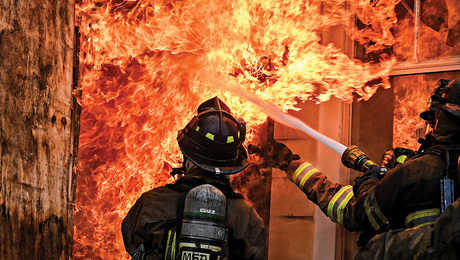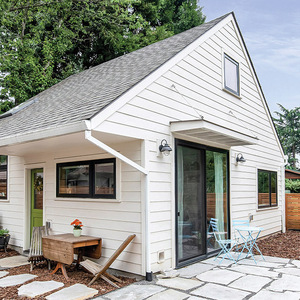Give me all of your thoughts, please. All the negatives for consideration. I am seeing a few high end Adirondack great camp style homes being built this way. 2×6 framing is used throughout, for exterior and all interior walls, and everything is 2/0 on center.
Discussion Forum
Discussion Forum
Up Next
Video Shorts
Featured Story

Smart construction decisions and material choices can significantly improve occupant safety and survival in the event of a fire in the home.
Highlights
"I have learned so much thanks to the searchable articles on the FHB website. I can confidently say that I expect to be a life-long subscriber." - M.K.
Fine Homebuilding Magazine
- Home Group
- Antique Trader
- Arts & Crafts Homes
- Bank Note Reporter
- Cabin Life
- Cuisine at Home
- Fine Gardening
- Fine Woodworking
- Green Building Advisor
- Garden Gate
- Horticulture
- Keep Craft Alive
- Log Home Living
- Military Trader/Vehicles
- Numismatic News
- Numismaster
- Old Cars Weekly
- Old House Journal
- Period Homes
- Popular Woodworking
- Script
- ShopNotes
- Sports Collectors Digest
- Threads
- Timber Home Living
- Traditional Building
- Woodsmith
- World Coin News
- Writer's Digest


















Replies
I framed two of my houses (2 & 3 houses ago) I lived in with 2x6's. Much better insulation and sturdier when the ceilings are nine foot high or better especially, and I love the deep set interior window and door jambs. Why 24" on center though? It really isnt all that many more studs to go 16 O.C. Personally I love 2x6 framing.
Be a stud,
Namaste
andy
"Attachment is the strongest block to realization"
http://CLIFFORDRENOVATIONS.COM
Andy, we are all studs here. Local codes prohibit the use of 2x4 framing for exterior walls.
"Local codes prohibit the use of 2x4 framing for exterior walls."
Gene - My understanding is that 2x4's make for a plenty strong wall structurally, but many builders find 2x6 framing the easiest way to meet energy codes. I think a lot depends on your local climate, insulation product familiarity and the load requirements of the specific wall.
Last year I framed a roof with I-joists spaced 19.2" o.c., sheathed with 1/2" o.s.b. and it was plenty stiff. I have never really liked 1/2" o.s.b. sheathing over trusses 24" o.c. because of the dips and humps, even with H-clips. But this roof was plenty stout and flat as a pool table...well, almost...anyway, it saved a few hundred dollars in materials and I'll use that spacing again. I might even space studs 19.2" next time in the bearing wall under the rafters.
Long answer, I know. Sorry. But what I'm saying is, there might be more to selecting stud size and spacing than code requirements.
Gene,
Some contractors in my area go 2'o.c. so that everything lines up.(trusses, studs) I asked a couple of them why and I really didn't get an answer. I go 16"o.c. on all my wall framing. I also use 2x6 for all exterior studs, 2x4 for interior.
Greg
Edited 1/5/2003 10:57:40 AM ET by gwerner
An outfit I worked for in Chico Ca in the 80s that was production oriented (200 units/year) tried 2' centers for one phase of a subdivision. We only tried it once. The biggest problem was trying to keep the walls flat. Studs as they are these days are not that straight. The walls were just too cattywhompus by the time the rockers showed up. We were trying to make "high end" stuff too but 2' centers made that too tall an order.
I've framed many a wall out of 2x6s, 24" oc.
Haf-inch ply sheathing on the exterior, though I do use 5/8ths sheetrock on the interior. I've never had a problem gettiing a straight wall. First floors are 9-10' tall, second 8'-ish.
I've used a lot of TJIs, either at 16" or 19.2" oc. Never trussed a roof, always done them stick by stick. I double up the top plates.
I see no reason to not frame 24"oc.
Gene,
We must be behind in time here in New Jersey because I've never seen walls being framed 2' o/c befor exterior or interior. We use 2x6 for walls but not all the time.
Do they still use ½ for the sheathing and ½ for sheetrock?
What does it do for ½ sheetrock walls 2' o/c?
To me it sounds like a cheaper and less quality job high end or not.
What happens when you have to frame a house where your floor joists have to be 12" o/c? Do you have to put a header in when every other beam lands in the middle? There's a reason why we frame 16" o/c.
It's amazing how things change. Next we'll be putting 2x floor and ceiling joists and rafters 2' o/c, stick framing.
I would like to here the benefits framing 2' o/c exterior and interior also and an explanation why we've been framing 16" o/c for all these years and now it's ok to frame 2' o/c.
Joe Carola
Edited 1/5/2003 12:53:35 PM ET by Framer
Edited 1/5/2003 6:41:32 PM ET by Framer
Joe
Its obvious why they use 24" O.C. Its not stronger.Its not prettier...
ITS CHEAPER!
If I saw a house framed 2' OC all I would think is that theyre skimping other places as well. After all, how many extra studs does it take per exterior wall to go on 16" centers? Not many. If youre a big builder and framing a lot of homes the contractor might say its a lot more money he's saving, but if he's building lots of homes he's "making" more money so whats the rational? Around here on L.I in N.Y about 15 years ago when there was that first energy crunch the codes called for 2x6 framing for energy purposes. I know that as of Jan 1, 03 the codes have changed dramatically again here. I'm not sure what the changes are yet but my architect recommeded that we get our plans into the building department before then. I brought the plans in Dec 30....whewww.
I'm guessing the 2x6 framing may be back for building codes again.
Be a stud
Namaste'
Andy"Attachment is the strongest block to realization"http://CLIFFORDRENOVATIONS.COM
Andy,
Gene said, "Local codes prohibit the use of 2x4 framing for exterior walls"
This is what I mean about the way things change. I've never heard of that one either.
We use both 2x4 and 2x6 walls all the time for exterior.
I always here about shear walls and read about them and see the way people use different straps and bolts and wind braces alot on the west coast, understandable with earthquakes and all. I don't disagree with any of it.
In NJ the word shear wall is never mentioned, no special bracing, no wind braces, no straps, no bolts, just nail the sheathing up horizontaly with cdx fir or verticaly with osb.
We use foundation bolts to hold our sills down and that's even starting to fade away because alot of houses are being biult with foundation straps instead of foundation bolts. I don't like the straps, there a joke. It's alot easier than drilling for foundation bolts but I wouldn't use them on my house.
All I want to do is do the right thing not a cheaper and faster way but the best and strongest way.
Joe Carola
Joe
The foundation bolts around here always seemed like a joke to me. In fifty years I can't remember one time when we had a hurricane, tornado or serious wind storms. Whats the point? Maybe like termite shield. That seems like a joke to me too but its always on the plans around here.
a"Attachment is the strongest block to realization"http://CLIFFORDRENOVATIONS.COM
Andy,
"Maybe like termite shield. That seems like a joke to me too but its always on the plans around here."
Now that's something we use to use years ago but not anymore. We just use sill sealer and put the sills right on top.
If the foundation bolts and straps are equal(You can never get a straight answer on that) and all the architects start using them I'm all for it because I do hate putting sills down and drilling all those holes. This is the only part about framing I don't like. Thank God I use the bolt markers, they make it go alot faster.
Joe Carola
Joe,
What are bolt markers?
a"Attachment is the strongest block to realization"http://CLIFFORDRENOVATIONS.COM
http://www.bestconstructiontools.com/indexa.html
the new IRC code does not require 2x6 walls unless the walls go over 9', it is also dependent on the design wind load..and subject to any amendments your state may have adopted
we went to 2x6 @ 24" in the '70's , but we're back to 2x4 @ 16" for better insulation techniques and straighter walls....Mike Smith Rhode Island : Design / Build / Repair / Restore
Andy,
The Bolt Marker is a tool that at the end has settings for half the thickness of different size foundation bolts that you butt right into the foundation bolt and welded back at 3-1/2" and 5-1/2" from the center of the foundation bolt are small little bolts with points on the bottom and a handle that you will see on the website.
You come in and snap your line for a 3-1/2" sill or a 5-1/2" sill and lay your 2x on the mark and back towards the inside of the foundation and then just butt your bolt marker into the foundation bolt and eyeball it square to your sill and hit the top of your 3-1/2" or 5-1/2" bolt with your hammer and it marks the exact center of your foundation bolt.
Once you use this you will never use anything else.
Go to Products and then Bolt Hole Marker.
Also look at the other stuff they have.
http://www.bigfootsaws.com
Joe Carola
Edited 1/7/2003 12:29:43 AM ET by Framer
Joe
Very cool..As far as that layout stick though...that tool doesnt seem much more helpful then a ruler. Whatya think
a"Attachment is the strongest block to realization"http://CLIFFORDRENOVATIONS.COM
Andy,
I have two of the layout sticks, their pretty good, it's like having 3 framing squares all in one. Instead of just marking 16" o/c and moving the square to mark the next 16" o/c, you can mark 16", 32", 48" centers each time you hold it, stud marks and top plate beam marks. Then move the square, next 3 marks.
It all depends on how your comfortable with laying out. I was taught to layout with a framing square but if you don't hold the framing square the right way on each 16" o/c mark you can be way off at the end as I did the first time I laid out a long wall, about 1" out.
There's actually less room for era with a layout stick because your marking every 4' instead or every 16".
I use it on small additions but on houses with long walls I'll use my tape and mark all the exterior walls first and then grab someone else and one guy on the back wall and one guy on the front wall and then I'll snap lines on the top plates and that marks all the interior partitions and everything is nice and straight and then do the same for the side walls.
Therte's an interesting thread about "Bag-o-tricks" with different guys showing their little tricks on framing that you might find interesting.
http://www.jlconline.com/cgi-bin/jlconline.storefront/3e1b5038001ca04f271a401e1d2905b6/Catalog/1139?read=5963
Joe Carola
Edited 1/7/2003 5:40:30 PM ET by Framer
Joe
I'm no framer by trade ...as in doing it every day. I have however framed dozens of houses and additions. I never use just a square for the reason you mentioned. By the time I get to the end I'm off often so I just run my tape full length and mark each red tape mark at 16"oc then go back with my framing square and draw the lines....Use my small adjustable square to mark the faces down the three plates.
Seems as though you could make one of those things with a six foot piece of 1x3 pretty easily.....I still don't get the point though. a tape seems pretty adequate. Just more toys.
Be well
namaste
Andy"Attachment is the strongest block to realization"http://CLIFFORDRENOVATIONS.COM
We use 6 " walls fulltime.....have used both 24"c/c & 16" c/c..personally the 16" makes a much easier time for us..i.e.,,,,,we dont have to use large modular headers over openings.....at the end of the day the difference on a one off house is not really huge...I read somewhere that 16" c/c is a leftover from the days of lath & plaster walls.....and thus it has remained as a standard
Try this: When I lived in BC I framed our home with 2x6 on 2' centers. Put in R-22 batt insulation and 6 mil vapor barrier over that. Ripped 2/6's into 2x3's and placed them horizontally over the vapor barrier on 16" centers. Placed all electric outlets (sideways on the 2x3's) Put 2" of fibreglas between the 2x3's and then put on the sheet rock. The only penetration of the vapor barrier was the drain/vent from the kitchen sink. My wife liked deep window sills too.
The 2x6 wall system came about in the seventies with the first energy crunch. The reason for 24"oc was to reduce the thermal bridging and to keep the cost similar to 2x4 @ 16oc.
That ended up causing too many wavy walls and requireing more wood for blocking in some locations. Most of us went back to 16"oc to take care of that or back to walls that were 2x4 with foam sheathing under the SR for preventing thermal bridging.
You mention adirondack style which implies to me that you are more likely to be having interior wall finishes in 1x6 V-groove pine or some other solid wood. That might make 2x6@24"oc appealing or at least acceptable.
Excellence is its own reward!
"The first rule is to keep an untroubled spirit.
The second is to look things in the face and know them for what they are."
--Marcus Aurelius